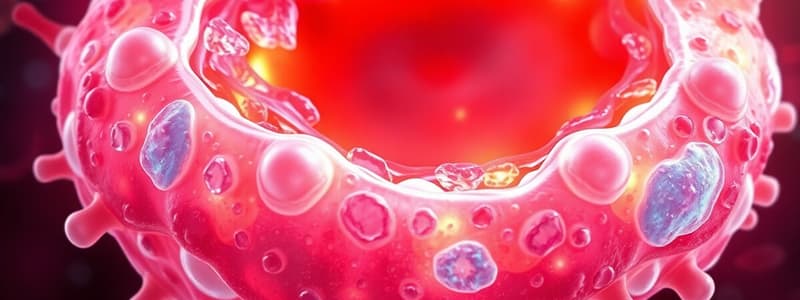Podcast
Questions and Answers
What is an epithelial cell?
What is an epithelial cell?
A type of cell that lines the surfaces and cavities of organs and structures throughout the body.
What characterizes muscle tissue?
What characterizes muscle tissue?
Tissue responsible for the contraction and movement of the body.
What are the types of bone cells?
What are the types of bone cells?
Osteoblasts, osteocytes, and osteoclasts.
What is the function of blood cells?
What is the function of blood cells?
What is a nerve cell?
What is a nerve cell?
What distinguishes a plant cell from an animal cell?
What distinguishes a plant cell from an animal cell?
Study Notes
Epithelial Cells
- Form the protective outer layer of the body and line internal organs.
- Characterized by closely packed cells with minimal extracellular matrix.
- Classification includes simple (single layer) and stratified (multiple layers) epithelium.
- Functions include absorption, secretion, filtration, and sensation.
- Specialized types include squamous, cuboidal, and columnar, depending on cell shape.
Muscle Tissue
- Composed of fibers that contract to facilitate movement.
- Three types of muscle tissue: skeletal (voluntary), cardiac (involuntary), and smooth (involuntary).
- Skeletal muscle: striated appearance, attached to bones via tendons, controlled voluntarily.
- Cardiac muscle: striated, found only in the heart, contracts rhythmically without conscious control.
- Smooth muscle: non-striated, found in walls of hollow organs, controlled involuntarily.
Types of Bone Cells and Blood Cells
- Bone cells include osteoblasts (bone formation), osteocytes (maintain bone tissue), and osteoclasts (bone resorption).
- Blood cells consist of erythrocytes (red blood cells, transport oxygen), leukocytes (white blood cells, immune response), and thrombocytes (platelets, blood clotting).
- Bone cells play a vital role in mineral homeostasis and structural support.
- Blood cells are essential for transporting oxygen, fighting infection, and clotting blood.
Nerve Cells
- Composed of neurons (signal transmission) and glial cells (support and protection).
- Neurons consist of a cell body, dendrites (receive signals), and axons (send signals).
- Communicate via electrical impulses and neurotransmitters.
- Function in processing and transmitting information throughout the nervous system.
Plant Cells
- Contain a rigid cell wall, chloroplasts for photosynthesis, and large central vacuoles for storage.
- Unique structures include plasmodesmata for cell communication and support.
- Plant cells perform photosynthesis, converting sunlight into energy.
- Differ from animal cells by having chloroplasts, a cell wall, and a central vacuole.
Studying That Suits You
Use AI to generate personalized quizzes and flashcards to suit your learning preferences.
Description
Explore the fascinating world of cells and tissues in this comprehensive report covering epithelial cells, muscle tissue, different types of bone and blood cells, nerve cells, and plant cells. Understand the unique characteristics and functions of each type of cell discussed in the report. Perfect for students looking to deepen their knowledge of biology.




